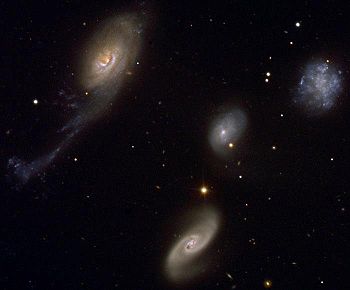Roberts Quartet
| Data from Robert's Quartet compact galaxy group |
|
|---|---|

|
|
| Constellation | Phoenix |
|
Position Epoch : J2000.0 Equinox : J2000.0 |
|
| Right ascension | 00 h 21 m 23 s |
| declination | −48 ° 37 ′ 20 ″ |
| Appearance | |
| Apparent brightness (visual) | 13 likes |
| Angular expansion | 1.6 ' |
| Number of galaxies | 4th |
| Brightest member | NGC 92 |
| Physical data | |
| distance | about 160 million light years |
| history | |
| discovery | John Frederick William Herschel |
| Discovery date | September 30, 1834 |
| Catalog names | |
| AM 0018-0485 | |
The Roberts Quartet is a compact group of galaxies that is approximately 160 million light years from Earth. The constellation is found near the center of the Phoenix constellation . In summary, it represents a family of four very different galaxies that are in a process of mutual influence . The cluster includes the galaxies NGC 87 , NGC 88 , NGC 89 and NGC 92 , all of which were discovered by John Herschel on September 30, 1834.
description
NGC 87 (top right) is an irregular galaxy, similar to the Magellanic Clouds in the vicinity of our Milky Way Galaxy . NGC 88 (center) is a barbed spiral galaxy with a rambling external envelope that is most likely composed of gas. NGC 89 (bottom center) is a barred spiral galaxy with two large spiral arms. The largest member of the system is NGC 92 (top left), a spiral galaxy of the morphological type Sa with an unusual appearance. One of its arms, about 100,000 light years long, has been deformed through interaction and contains a large amount of dust.
The quartet is one of the best examples of a compact group of galaxies. Since such groups of four to eight galaxies can be found in a relatively small area, they represent excellent study objects for the investigation of galactic interactions and their effects, especially on the constellation of stars. The quartet has a total apparent brightness of almost 13. The brightest member of the group has a visual magnitude of 13.8. In the sky, the four galaxies are united within a radius of 1.6 arc minutes , which is equivalent to a distance of 75,000 light years.
Origin of name
They were named by the astronomers Halton Arp and Barry F. Madore, who in 1987 compiled the directory A Catalog of Southern Peculiar Galaxies and Associations (a catalog of the unusual galaxies and associations in the southern hemisphere). It was named after Robert Freedman, who calculated many of the updated positions of the galaxies for the catalog.
Members
| Surname | Type | Distance from the sun (million ly ) |
Magnitude |
|---|---|---|---|
| NGC 87 | IBm pec. | ~ 160 | +14.7 |
| NGC 88 | SB (rs) a pec. | ~ 160 | +15.0 |
| NGC 89 | SB0 (s) a pec. | ~ 160 | +14.2 |
| NGC 92 | SAa pec. | ~ 160 | +13.8 |
See also
Individual evidence
- ↑ a b c d www.eso.org ( Memento of the original from October 11, 2008 in the Internet Archive ) Info: The archive link was inserted automatically and has not yet been checked. Please check the original and archive link according to the instructions and then remove this notice.
Web links
- Image from Roberts Quartet
- Capella Observatory
- ESO: Cosmic Portrait of a Perturbed Family November 4, 2005
- astronews.com: Picture of the day December 6, 2011